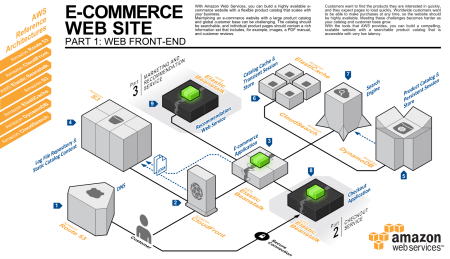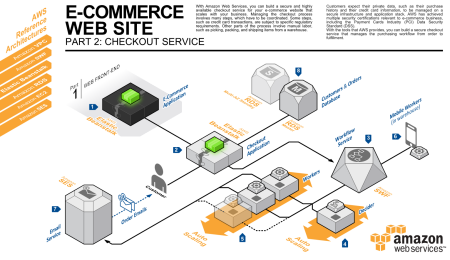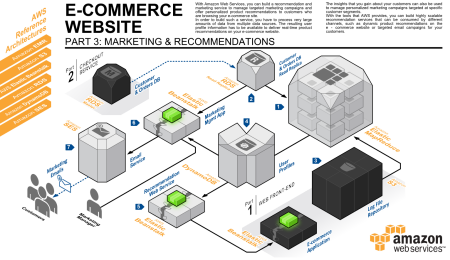Three New AWS Reference Architectures for E-Commerce | AWS Official Blog
Read full article from Three New AWS Reference Architectures for E-Commerce | AWS Official Blog
Web Frontend
This is a reference architecture for the web frontend of an e-commerce site. It makes use of Route 53, CloudFront, Elastic Beanstalk, S3, ElastiCache, DynamoDB and CloudSearch:
This is a reference architecture for the web frontend of an e-commerce site. It makes use of Route 53, CloudFront, Elastic Beanstalk, S3, ElastiCache, DynamoDB and CloudSearch:
Checkout Pipeline
This is a reference architecture for a secure and highly available checkout pipeline service for an e-commerce site. It uses the Virtual Private Cloud, the Simple Workflow Service, Elastic Beanstalk, the Relational Database Service, and the Simple Email Service.
This is a reference architecture for a secure and highly available checkout pipeline service for an e-commerce site. It uses the Virtual Private Cloud, the Simple Workflow Service, Elastic Beanstalk, the Relational Database Service, and the Simple Email Service.
Marketing & Recommendations Service
This is a reference architecture for a marketing and recommendation service for an e-commerce site. It uses Elastic MapReduce, S3, Elastic Beanstalk, the Relational Database Service, DynamoDB, and the Simple Email Service:
http://dp2.me/blog/?p=474This is a reference architecture for a marketing and recommendation service for an e-commerce site. It uses Elastic MapReduce, S3, Elastic Beanstalk, the Relational Database Service, DynamoDB, and the Simple Email Service:
本文内容基本基于 e-commerce best practices (how to market, sell and service customers with internet technologies
一、基本需求
让我们先看一下一个e-commerce网站的基本需求是什么。在e-commerce best practices 中,作者列举了很多e-commerce website的feature,但是比较分散。我们在这里摘录其中最基本的:
1. 展示产品:
- 富媒体展示产品(1.5) (Nike) 【】
- 搜索产品(4.12) (Nike) 【按照产品名称、颜色、型号等搜索】
- 产品分类(4.12)(Nike) 【本质基本等同于搜索,但是使用一组预先设定的参数】
- 添加产品至购物车 (2.2) 【guest cart的处理,以及merge carts】
2. 结算与支付:
- 结算流程(2.3) 【安全性、税款和运费】
- 支付(2.4) 【支持多种付款方式、使用银行/Paypal服务】
- 欺诈预防(2.5)【基本检测、欺诈检测子系统、手工审查】
3. 销售:
- 订单管理(2.16)【实时性、客户/客服界面一致性、与运送系统良好集成】
- 物流/仓储系统(2.6) 【信息交换、支持退货】
- 物品清单管理(2.7) 【同步】
4. 客服:
- 即时chat (3.1)
- 客户电话 (3.7)
- 同步客户浏览状态 (3.1)
- 迅速查询修改客户订单/账户状态 (3.1)
- 权限控制与case转移 (3.1)
二、e-commerce成长的必需品
除去以上的基本需求外,e-commerce网站需要以下的特性来帮助business方面做出更好的判断:
1. 分析工具(analytics): (4.10)
- 网页分析工具(4.10.2 分析用户在每一个网页上的active停留时间和点击)
- 搜索结果相关性分析 (4.12)
- 用户反馈 (这个书上没提,但是我经常看到网站有online survey)
- abandoned cart(2.2.2 实在找不到对应的中文,就是买到一半扔掉的cart)
- 退货原因分析 (3.2)
- 用户评价 (2.9)
卖家同时需要用以下手段帮助其更好地推销他们的产品:
2. 帮助卖家更好地销售的工具:
- email和简报,RSS (1.2, 1.10, 4.15)
- 个性化 (4.11)
- 搜索引擎优化——SEO (1.1)
- 附加销售 (2.1 原文up-selling,即在用户checkout和浏览时提示用户经常/可以同时购买的商品,等——推荐系统)
- 优惠 (1.4)
3. 网站技术需求:
- 低延迟 (4.7)
- scale up的情况下可支持高并发
- 高可靠性
- 支持秒杀、促销活动 (1.3.4)
三、依据以上需求进行的设计
- e-commerce的问题很容易分解,所以SOA是一个很自然的选择 (4.3)
- 根据4.3.7节的建议,我们可以整理出一系列的子系统。在4.9.2节,作者给出了e-commerce网站的infrastructure结构图
- 最后想想这个架构对我来说比较敏感,我就用两张网上抓来的图表示一下自己的想法:
这俩图上很多东西没有表现出来,比如说search/index可以是一个服务,inventory management可以是一个服务,fulfillment可以是一个服务,order management可以是一个服务。。。。总之就一堆圈,有关系的俩圈就画条线。。。
Read full article from Three New AWS Reference Architectures for E-Commerce | AWS Official Blog


